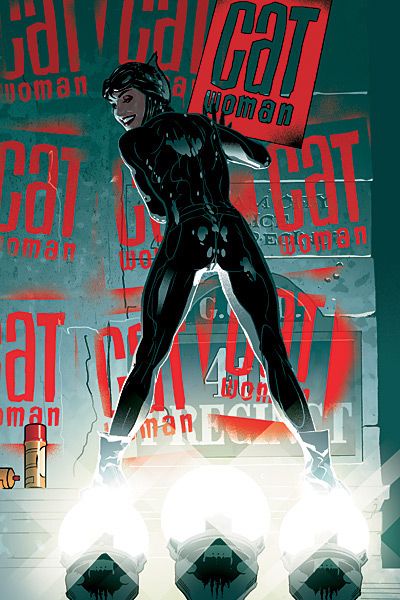"Catwoman" is ending after the next issue, sadly. It's safe to say that this incarnation of Catwoman, launched in 2001 by Ed Brubaker and Darwyn Cooke, has been the best sustained look at Selina Kyle in the 68 years of her existence. The series suffered a bit in the middle of its run before Will Pfeifer took over but, as a whole, its seven-year run has been a pleasure to read. Pfeifer, in particular, has developed a strong emotional subtext for the character, and I hope to see him working on more DC projects in the future.
Issue #81 is a good example of what made this series work. It's the beginning of the end for "Catwoman," as the two-part story will conclude next month and that will be it for the ongoing series, but it's still representative of what Pfeifer has done well with the status-quo established by Brubaker and Cooke.
The issue begins with Catwoman stealing a cheesecake painting of herself from an art gallery. It's a funny nod to the Adam Hughes covers that have often pictured a much more sexualized Selina Kyle than the one we've seen between the covers. And the painting she steals is actually the cover painting to this very issue, but it's not played as metafiction. It's just Catwoman stealing a painting and having fun stealing from the police on the way out. There's a moral code to her actions -- after all, Brubaker and Cooke established Selina Kyle as a kind of Gotham City Robin Hood -- but there's also a sense of loss inside the character. She's given up so much in the past 81 issues -- many of her friends, her lover, even her own daughter -- and the levity seems to be part of Catwoman's act. She plays the thrillseeker because she has to. The alternative is unimaginable. And who wants to see a sullen Catwoman, anyway?
The opening art heist is just a precursor to the main plot, which details the theft of a very special painting -- a theft sponsored by the Calculator, who has had a rocky relationship with Catwoman in recent years. Their banter shows why Pfeifer is so good as the writer of a superhero ongoing series. He quickly reminds the reader of their relationship (they've betrayed each other in the recent past), but he doesn't linger on it. He establishes just enough to clarify the dynamic between them, but he moves on, allowing the subtext to inform the dialogue that follows, but not letting it slow down the narrative.
Like all of Pfeifer's issues, this is a swift-moving story with action and humor and drama. When Batman shows up at the end, it's no real surprise -- who else would show up to put a capstone on Selina's comic book series? -- but it's well-handled and ends with an almost literal cliffhanger.
And let's not forget the art of David and Alvaro Lopez who have been consistently excellent for years. These guys deserve a major DC book as much as Pfeifer, and their style has been a perfect fit for "Catwoman."
It's probably futile to review a comic book so close to cancellation, but "Catwoman" readers know how good this series has been, and if you dropped the series somewhere along the way, you might want to check out the last few years of the comic and see what you've missed. This isn't one of those comics that's limping to the finish line. It's not a mercy killing. "Catwoman" is a good comic book, standing tall even as it faces its demise.

